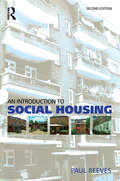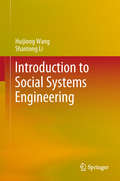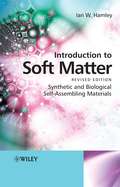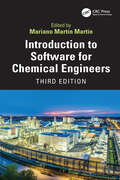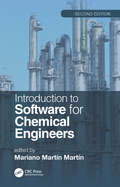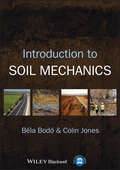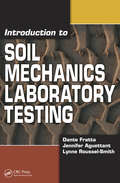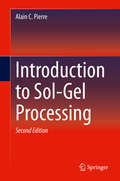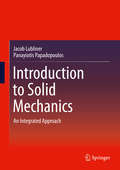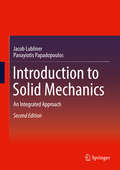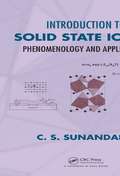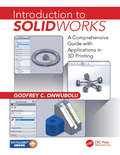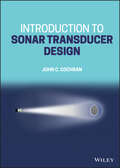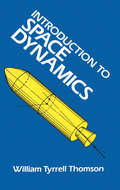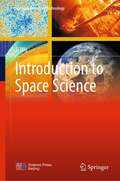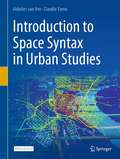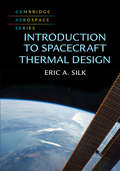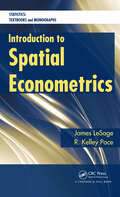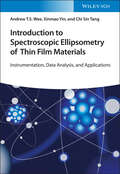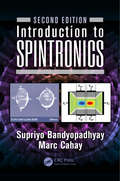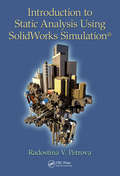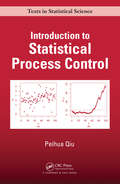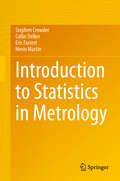- Table View
- List View
Introduction to Social Housing
by Paul ReevesThe provision and management of social housing for those who are unable to access the housing market is essential to the maintenance of the fabric of society. The social housing industry is vast and still growing. There are very few countries in the world where some form of subsidised housing does not exist, and the total number of social homes is likely to grow worldwide, as are the challenges of the sector.Paul Reeves takes a people-centred approach to the subject, describing the themes that have run through provision of social housing from the first philanthropic industrialists in the 19th Century though to the increasingly complex mixture of ownerships and tenures in the present day. The management of housing forms a key part of the book, with an emphasis on the practical aspects of tenant participation and multi-agency working.The book is ideal for students of housing and social policy, and for housing professionals aiming to obtain qualifications and wanting a broad understanding of the social housing sector.
Introduction to Social Systems Engineering
by Shantong Li Huijiong WangThis book integrates the basic theories (GST and Parson’s AGIL framework), applying them to the components of social systems, state-run and business firms. China’s development experience offers a valuable case study that can provide readers deeper insights into this comparatively young discipline, and into China. Though the discipline of systems engineering and its application to hardware engineering system are well established, social systems engineering is an emerging discipline still being explored. This book may be the first English-language publication on this promising subject.
Introduction to Soft Matter
by Ian W. HamleyThis book provides an introduction to this exciting and relatively new subject with chapters covering natural and synthetic polymers, colloids, surfactants and liquid crystals highlighting the many and varied applications of these materials. Written by an expert in the field, this book will be an essential reference for people working in both industry and academia and will aid in understanding of this increasingly popular topic. Contains a new chapter on biological soft matterNewly edited and updated chapters including updated coverage of recent aspects of polymer science.Contain problems at the end of each chapter to facilitate understanding
Introduction to Software for Chemical Engineers
by Mariano Martín MartínThe field of chemical engineering and its link to computer science is in constant evolution, and engineers have an ever-growing variety of tools at their disposal to tackle everyday problems. Introduction to Software for Chemical Engineers, Third Edition provides a quick guide to the use of various computer packages for chemical engineering applications. It covers a range of software applications, including Excel and general mathematical packages such as MATLAB®, MathCAD, R, and Python. Coverage also extends to process simulators such as CHEMCAD, HYSYS, and Aspen; equation-based modeling languages such as gPROMS; optimization software such as GAMS, AIMS, and Julia; and specialized software like CFD or DEM codes. The different packages are introduced and applied to solve typical problems in fluid mechanics, heat and mass transfer, mass and energy balances, unit operations, reactor engineering, and process and equipment design and control.This new edition is updated throughout to reflect software updates and new packages. It emphasizes the addition of SimaPro due to the importance of life cycle assessment, as well as general statistics software, SPSS, and Minitab that readers can use to analyze lab data. The book also includes new chapters on flowsheeting drawing, process control, and LOOP Pro, as well as updates to include Pyomo as an optimization platform, reflecting current trends. The text offers a global idea of the capabilities of the software used in the chemical engineering field and provides examples for solving real-world problems.Written by leading experts, this handbook is a must-have reference for chemical engineers looking to grow in their careers through the use of new and improving computer software. Its user-friendly approach to simulation and optimization, as well as its example-based presentation of the software, makes it a perfect teaching tool for both undergraduate- and graduate-level readers.
Introduction to Software for Chemical Engineers, Second Edition
by Mariano Martín MartínThe field of Chemical Engineering and its link to computer science is in constant evolution and new engineers have a variety of tools at their disposal to tackle their everyday problems. Introduction to Software for Chemical Engineers, Second Edition provides a quick guide to the use of various computer packages for chemical engineering applications. It covers a range of software applications from Excel and general mathematical packages such as MATLAB and MathCAD to process simulators, CHEMCAD and ASPEN, equation-based modeling languages, gProms, optimization software such as GAMS and AIMS, and specialized software like CFD or DEM codes. The different packages are introduced and applied to solve typical problems in fluid mechanics, heat and mass transfer, mass and energy balances, unit operations, reactor engineering, process and equipment design and control. This new edition offers a wider view of packages including open source software such as R, Python and Julia. It also includes complete examples in ASPEN Plus, adds ANSYS Fluent to CFD codes, Lingo to the optimization packages, and discusses Engineering Equation Solver. It offers a global idea of the capabilities of the software used in the chemical engineering field and provides examples for solving real-world problems. Written by leading experts, this book is a must-have reference for chemical engineers looking to grow in their careers through the use of new and improving computer software. Its user-friendly approach to simulation and optimization as well as its example-based presentation of the software, makes it a perfect teaching tool for both undergraduate and master levels.
Introduction to Soil Mechanics
by Colin Jones Béla BodóIntroduction to Soil Mechanics, Béla Bodó & Colin Jones Introduction to Soil Mechanics covers the basic principles of soil mechanics, illustrating why the properties of soil are important, the techniques used to understand and characterise soil behaviour and how that knowledge is then applied in construction. The authors have endeavoured to define and discuss the principles and concepts concisely, providing clear, detailed explanations, and a well-illustrated text with diagrams, charts, graphs and tables. With many practical, worked examples and end-of-chapter and coverage of Eurocode 7, Introduction to Soil Mechanics will be an ideal starting point for the study of soil mechanics and geotechnical engineering. About the Authors Béla Bodó B.Sc., B.A., C.Eng., M.I.C.E, was born in Hungary and studied at Budapest Technical University, the University of London and the Open University. He developed his expertise in Soil Mechanics during his employment with British Rail and British Coal. Colin Jones B.Sc, C. Eng., M.I.C.E, P.G.C.E, studied at the University of Dundee, and worked at British Coal where he and Béla were colleagues. He has recently retired from the University of Wales, Newport where he was Programme Director for the Civil Engineering provision, specializing in Soil Mechanics and Geotechnics. Also Available Fundamentals of Rock Mechanics 4th Edition J C Jaeger, N G W Cook and R Zimmerman Hardcover: 9780632057597 Smith's Elements of Soil Mechanics 8th Edition Ian Smith Paperback: 9781405133708
Introduction to Soil Mechanics Laboratory Testing
by Dante Fratta Jennifer Aguettant Lynne Roussel-SmithA step-by-step text on the basic tests performed in soil mechanics, Introduction to Soil Mechanics Laboratory Testing provides procedural aids and elucidates industry standards. It also covers how to properly present data and document results. Containing numerical examples and figures, the information presented is based on American Society f
Introduction to Soils and Soil Science: Laboratory Exercises
by Murray H. MilfordLab Manual that explores soil science
Introduction to Sol-Gel Processing (International Series In Sol-gel Processing #1)
by Alain C. PierreThis book presents a broad, general introduction to the processing of Sol-Gel technologies. This updated volume serves as a general handbook for researchers and students entering the field. This new edition provides updates in fields that have undergone rapid developments, such as Ceramics, Catalysis, Chromatropgraphy, biomaterials, glass science, and optics. It provides a simple, compact resource that can also be used in graduate-level materials science courses.
Introduction to Solid Mechanics
by Jacob Lubliner Panayiotis PapadopoulosIntroduction to Solid Mechanics: An Integrated Approach presents for the first time in one text the concepts and processes covered in statics and mechanics of materials curricula following a granular, topically integrated approach. Since the turn of the millennium, it has become common in engineering schools to combine the traditional undergraduate offerings in rigid-body statics (usually called "statics") and deformable body mechanics (known traditionally as "strength of materials" or, more recently, "mechanics of materials") into a single, introductory course in solid mechanics. Many textbooks for the new course sequentially meld pieces of existing, discrete books--sometimes, but not always, acknowledging the origin--into two halves covering Statics and Mechanics of Materials. In this volume, Professors Lubliner and Papadopoulos methodically combine the essentials of statics and mechanics of materials, illustrating the relationship of concepts throughout, into one "integrated" text. Introduction to Solid Mechanics: An Integrated Perspective offers a holistic treatment of the depth and breadth of solid mechanics, proceeding from first principles to applications.
Introduction to Solid Mechanics: An Integrated Approach
by Jacob Lubliner Panayiotis PapadopoulosThis expanded second edition presents in one text the concepts and processes covered in statics and mechanics of materials curricula following a systematic, topically integrated approach. Building on the novel pedagogy of fusing concepts covered in traditional undergraduate courses in rigid-body statics and deformable body mechanics, rather than simply grafting them together, this new edition develops further the authors’ very original treatment of solid mechanics with additional figures, an elaboration on selected solved problems, and additional text as well as a new subsection on viscoelasticity in response to students’ feedback. Introduction to Solid Mechanics: An Integrated Approach, Second Edition, offers a holistic treatment of the depth and breadth of solid mechanics and the inter-relationships of its underlying concepts. Proceeding from first principles to applications, the book stands as a whole greater than the sum of its parts.
Introduction to Solid State Ionics: Phenomenology and Applications
by C. S. SunandanaIntroduction to Solid State Ionics: Phenomenology and Applications presents a pedagogical, graduate-level treatment of the science and technology of superionic conductors, also known as fast ion conductors or solid electrolytes. Suitable for physics, materials science, and engineering researchers and students, the text emphasizes basic physics and
Introduction to SolidWorks: A Comprehensive Guide with Applications in 3D Printing
by Godfrey C. OnwuboluThis senior undergraduate level textbook is written for Advanced Manufacturing, Additive Manufacturing, as well as CAD/CAM courses. Its goal is to assist students in colleges and universities, designers, engineers, and professionals interested in using SolidWorks as the design and 3D printing tool for emerging manufacturing technology for practical applications. This textbook will bring a new dimension to SolidWorks by introducing readers to the role of SolidWorks in the relatively new manufacturing paradigm shift, known as 3D-Printing which is based on Additive Manufacturing (AM) technology. This new textbook: Features modeling of complex parts and surfaces Provides a step-by-step tutorial type approach with pictures showing how to model using SolidWorks Offers a user-Friendly approach for the design of parts, assemblies, and drawings, motion-analysis, and FEA topics Includes clarification of connections between SolidWorks and 3D-Printing based on Additive Manufacturing Discusses a clear presentation of Additive Manufacturing for Designers using SolidWorks CAD software "Introduction to SolidWorks: A Comprehensive Guide with Applications in 3D Printing" is written using a hands-on approach which includes a significant number of pictorial descriptions of the steps that a student should follow to model parts, assemble parts, and produce drawings.
Introduction to Sonar Transducer Design
by John C. CochranINTRODUCTION TO SONAR TRANSDUCER DESIGN A comprehensive introduction to sonar transducer design, complete with real world examples, step-by-step instruction, and detailed mathematical review In Introduction to Sonar Transducer Design, renowned sensor engineer Dr. John C. Cochran delivers an instructive and comprehensive exploration of the foundations of sonar transducer design perfect for beginning and experienced professional transducer designers. The book offers a detailed mathematical review of the subject, as well as fulsome design examples. Beginning with a description of acoustic wave propagation, along with a review of radiation from a variety of sources, the book moves on to discuss equivalent circuit models that explain wave propagation in solids and liquids. The book reviews examples of projectors and hydrophones accompanied by complete mathematical solutions. All included math is developed from first principles to a final solution using an intuitive, step-by-step approach. Introduction to Sonar Transducer Design offers professionals and students the analytical tools and assumptions required for start-to-finish transducer design. It also provides: A thorough introduction to acoustic waves and radiation, including small signals, linear acoustics, the equations of continuity, motion, the wave equation in a fluid media, and integral formulations Comprehensive explorations of the elements of transduction, including various forms of impedance, and mechanical and acoustical equivalent circuits, as well as their combination Practical discussions of waves in solid media, including homogeneous, isotropic, elastic, and solid media, piezoelectricity and piezoelectric ceramic materials, and waves in non-homogeneous, piezoelectric media In-depth examinations of sonar projectors and sonar hydrophones, including the elements and tools of sonar projector and sonar hydrophone design, as well as their applications Perfect for sonar system engineers, particularly those involved in defense, Introduction to Sonar Transducer Design will also earn a place in the libraries of acoustic, audio, underwater communication, and naval engineers.
Introduction to Space Dynamics
by William Tyrrell ThomsonAlthough this classic introduction to space-flight engineering was first published not long after Sputnik was launched, the fundamental principles it elucidates are as varied today as then. The problems to which these principles are applied have changed, and the widespread use of computers has accelerated problem-solving techniques, but this book is still a valuable basic text for advanced undergraduate and graduate students of aerospace engineering.The first two chapters cover vector algebra and kinematics, including angular velocity vector, tangential and normal components, and the general case of space motion. The third chapter deals with the transformation of coordinates, with sections of Euler's angles, and the transformation of angular velocities.A variety of interesting problems regarding the motion of satellites and other space vehicles is discussed in Chapter 4, which includes the two-body problem, orbital change due to impulsive thrust, long-range ballistic trajectories, and the effect of the Earth's oblateness. The fifth and sixth chapters describe gyrodynamics and the dynamics of gyroscopic instruments, covering such topics as the displacement of a rigid body, precession and nutation of the Earth's polar axis, oscillation of the gyrocompass, and inertial navigation.Chapter 7 is an examination of space vehicle motion, with analyses of general equations in body conditions and their transformation to inertial coordinates, attitude drift of space vehicles, and variable mass. The eighth chapter discusses optimization of the performance of single-stage and multistage rockets. Chapter 9 deals with generalized theories of mechanics, including holonomic and non-holonomic systems, Lagrange's Equation for impulsive forces, and missile dynamics analysis.Throughout this clear, comprehensive text, practice problems (with answers to many) aid the student in mastering analytic techniques, and numerous charts and diagrams reinforce each lesson. 1961 edition.
Introduction to Space Science (Springer Aerospace Technology)
by Ji WuThis book highlights the technological and managerial fundamentals and frontier questions of space science. Space science is a new interdisciplinary and comprehensive subject that takes spacecraft as the main tools to study the planet Earth, the solar-terrestrial space, the solar system, and even the whole universe, to answer significant questions covering the formation and evolution of the solar system and the universe, the origin and evolution of life and the structure of the material. The book introduces major scientific questions in various branches of space science and provides related technological and managerial knowledge. It also discusses the necessity of international cooperation and elaborates on the strategic planning of space science in China. The book can be used as a reference book or textbook for scientists, engineers, college students, and the public participating in space science programs.
Introduction to Space Syntax in Urban Studies
by Claudia Yamu Akkelies van NesThis open access textbook is a comprehensive introduction to space syntax method and theory for graduate students and researchers. It provides a step-by-step approach for its application in urban planning and design. This textbook aims to increase the accessibility of the space syntax method for the first time to all graduate students and researchers who are dealing with the built environment, such as those in the field of architecture, urban design and planning, urban sociology, urban geography, archaeology, road engineering, and environmental psychology. Taking a didactical approach, the authors have structured each chapter to explain key concepts and show practical examples followed by underlying theory and provided exercises to facilitate learning in each chapter. The textbook gradually eases the reader into the fundamental concepts and leads them towards complex theories and applications. In summary, the general competencies gain after reading this book are:– to understand, explain, and discuss space syntax as a method and theory;– be capable of undertaking various space syntax analyses such as axial analysis, segment analysis, point depth analysis, or visibility analysis;– be able to apply space syntax for urban research and design practice;– be able to interpret and evaluate space syntax analysis results and embed these in a wider context;– be capable of producing new original work using space syntax.This holistic textbook functions as compulsory literature for spatial analysis courses where space syntax is part of the methods taught. Likewise, this space syntax book is useful for graduate students and researchers who want to do self-study. Furthermore, the book provides readers with the fundamental knowledge to understand and critically reflect on existing literature using space syntax.
Introduction to Space Systems
by Miguel A. AguirreThe definition of all space systems starts with the establishment of its fundamental parameters: requirements to be fulfilled, overall system and satellite design, analysis and design of the critical elements, developmental approach, cost, and schedule. There are only a few texts covering early design of space systems and none of them has been specifically dedicated to it. Furthermore all existing space engineering books concentrate on analysis. None of them deal with space system synthesis - with the interrelations between all the elements of the space system. Introduction to Space Systems concentrates on understanding the interaction between all the forces, both technical and non-technical, which influence the definition of a space system. This book refers to the entire system: space and ground segments, mission objectives as well as to cost, risk, and mission success probabilities. Introduction to Space Systems is divided into two parts. The first part analyzes the process of space system design in an abstract way. The second part of the book focuses on concrete aspects of the space system design process. It concentrates on interactions between design decisions and uses past design examples to illustrate these interactions. The idea is for the reader to acquire a good insight in what is a good design by analyzing these past designs.
Introduction to Spacecraft Thermal Design (Cambridge Aerospace Series #48)
by Eric A. SilkDevelop a fundamental understanding of heat transfer analysis techniques as applied to earth based spacecraft with this practical guide. Written in a tutorial style, this essential text provides a how-to manual tailored for those who wish to understand and develop spacecraft thermal analyses. Providing an overview of basic heat transfer analysis fundamentals such as thermal circuits, limiting resistance, MLI, environmental thermal sources and sinks, as well as contemporary space based thermal technologies, and the distinctions between design considerations inherent to room temperature and cryogenic temperature applications, this is the perfect tool for graduate students, professionals and academic researchers.
Introduction to Spatial Econometrics (Statistics: A Series of Textbooks and Monographs)
by James LeSage Robert Kelley PaceAlthough interest in spatial regression models has surged in recent years, a comprehensive, up-to-date text on these approaches does not exist. Filling this void, Introduction to Spatial Econometrics presents a variety of regression methods used to analyze spatial data samples that violate the traditional assumption of independence between observat
Introduction to Spectroscopic Ellipsometry of Thin Film Materials: Instrumentation, Data Analysis, and Applications
by Andrew Thye Wee Xinmao Yin Chi Sin TangA one-of-a-kind text offering an introduction to the use of spectroscopic ellipsometry for novel material characterization In Introduction to Spectroscopic Ellipsometry of Thin Film Materials: Instrumentation, Data Analysis and Applications, a team of eminent researchers delivers an incisive exploration of how the traditional experimental technique of spectroscopic ellipsometry is used to characterize the intrinsic properties of novel materials. The book focuses on the scientifically and technologically important two-dimensional transition metal dichalcogenides (2D-TMDs), magnetic oxides like manganite materials, and unconventional superconductors, including copper oxide systems. The distinguished authors discuss the characterization of properties, like electronic structures, interfacial properties, and the consequent quasiparticle dynamics in novel quantum materials. Along with illustrative and specific case studies on how spectroscopic ellipsometry is used to study the optical and quasiparticle properties of novel systems, the book includes: Thorough introductions to the basic principles of spectroscopic ellipsometry and strongly correlated systems, including copper oxides and manganites Comprehensive explorations of two-dimensional transition metal dichalcogenides Practical discussions of single layer graphene systems and nickelate systems In-depth examinations of potential future developments and applications of spectroscopic ellipsometryPerfect for master’s- and PhD-level students in physics and chemistry, Introduction to Spectroscopic Ellipsometry of Thin Film Materials will also earn a place in the libraries of those studying materials science seeking a one-stop reference for the applications of spectroscopic ellipsometry to novel developed materials.
Introduction to Spintronics
by Supriyo Bandyopadhyay Marc CahayIntroduction to Spintronics provides an accessible, organized, and progressive presentation of the quantum mechanical concept of spin and the technology of using it to store, process, and communicate information. Fully updated and expanded to 18 chapters, featuring many new drill problems, this edition reflects the explosion of study in spin-related physics, addressing seven important physical phenomena with spintronic device applications. It discusses spintronics without magnetism, which allows one to manipulate spin currents by purely electrical means. It explores lateral spin-orbit interaction and its many nuances, as well as the possibility to implement spin polarizers and analyzers using quantum point contacts. It also introduces the concept of single-domain-nanomagnet-based computing.
Introduction to Static Analysis Using SolidWorks Simulation
by Radostina V. PetrovaUses Finite Element Analysis (FEA) as Implemented in SolidWorks SimulationOutlining a path that readers can follow to ensure a static analysis that is both accurate and sound, Introduction to Static Analysis using SolidWorks Simulation effectively applies one of the most widely used software packages for engineering design to the concepts of static
Introduction to Statistical Process Control (Chapman & Hall/CRC Texts in Statistical Science)
by Peihua QiuA major tool for quality control and management, statistical process control (SPC) monitors sequential processes, such as production lines and Internet traffic, to ensure that they work stably and satisfactorily. Along with covering traditional methods, Introduction to Statistical Process Control describes many recent SPC methods that improve upon
Introduction to Statistics in Metrology
by Stephen Crowder Collin Delker Eric Forrest Nevin MartinThis book provides an overview of the application of statistical methods to problems in metrology, with emphasis on modelling measurement processes and quantifying their associated uncertainties. It covers everything from fundamentals to more advanced special topics, each illustrated with case studies from the authors' work in the Nuclear Security Enterprise (NSE). The material provides readers with a solid understanding of how to apply the techniques to metrology studies in a wide variety of contexts. The volume offers particular attention to uncertainty in decision making, design of experiments (DOEx) and curve fitting, along with special topics such as statistical process control (SPC), assessment of binary measurement systems, and new results on sample size selection in metrology studies. The methodologies presented are supported with R script when appropriate, and the code has been made available for readers to use in their own applications. Designed to promote collaboration between statistics and metrology, this book will be of use to practitioners of metrology as well as students and researchers in statistics and engineering disciplines.
